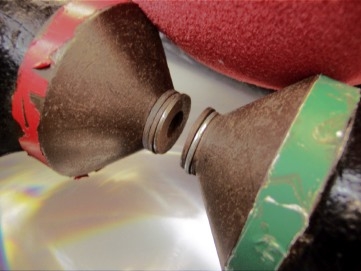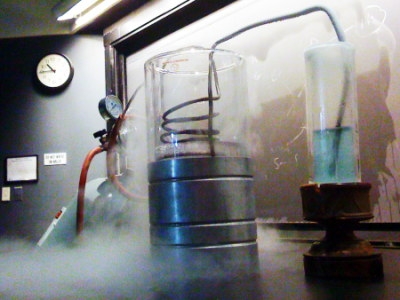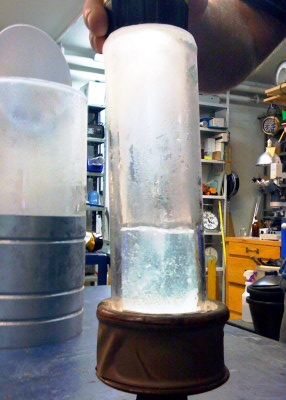What It Shows
A large magnet with a small cylindrical gap allows a stream of liquid nitrogen to pass over and through. Poured liquid oxygen hangs between the poles in the strong field until it boils away.
Video of the demo in action https://youtu.be/Lt4P6ctf06Q
How It Works
Pour the liquid nitrogen first, slowly over the pole pieces. The result is nothing but vapor condensation and crackling plexiglas; the liquid does not interact with the large magnetic field.
Next pour the liquid oxygen slowly over the pole pieces, and it collects in the gap between the poles. It might take two or three short pours to get the liquid oxygen to stick around, as it has to cool the poles first. When the liquid oxygen boils off the first time, pour LN2 again to show no interaction. The next slosh of oxygen will last for 30 or 40 seconds, suspended in the strong magnetic field. Nitrogen, nothing; oxygen, stickiness.
Setting It Up
The magnetron magnet is big and heavy, with conical pole pieces. The poles are extended with washers to leave about a one centimeter gap.

The magnet lies on a piece of plexiglas on an overhead projector. The plexiglass sheet acts to shield the overhead projector glass from the cryogenic liquids (unshielded glass is guaranteed to break). The plexiglass shields are stored standing up on the floor near the magnets.
The projector is parked close to the front row of lecture hall seats, and the shadow image of the magnet gap is projected onto the screen. Focus the projector so that a non-ferrous key held at the center of the gap is in focus (with the overhead projectors we have now, use the focusing lens at the bottom of the mirror assembly).

The liquid oxygen [Lox] is condensed in a copper coil, which is immersed in a large, glass Dewar flask of liquid nitrogen [LN2]. It is caught in the tall, thin glass Dewar, which should be pre-cooled with liquid nitrogen immediately before. The outlet tube of the condenser is placed within the thin Dewar at the same moment the coil part of the condenser is being lowered into the larger one. Top off the large LN2 Dewar from the 4 liter flask as necessary.
A good flow of oxygen will fill the Lox Dewar to three-quarters full in about five minutes. With the oxygen still flowing, slowly lift the entire condenser vertically, to catch the remaining Lox in the coils in the Lox Dewar. Shut off the gas flow from the O2 tank, and remove it and the condenser from the room.
Save the remaining LN2 in the 4 liter (non-magnetic aluminum) flask, to be used later to pour onto the magnet.

If the demonstrator still has liquid oxygen remaining, and wishes to demonstrate the acceleration of combustion, do the following. On a fireproof surface, place a 600 or 800 ml beaker. Carefully light the bottom edge of the cardboard cylinder from a paper towel roll (industrial-grade, thick cardboard cylinder from janitorial maintenance is what we typically use). The object is to get it smoldering evenly all around the bottom edge. Place the tube smoldering end down in the beaker, and carefully and quickly pour a good slosh, say 50 ml or so, into the beaker. Quickly stand back.